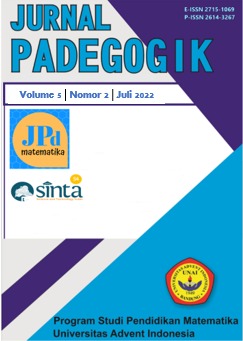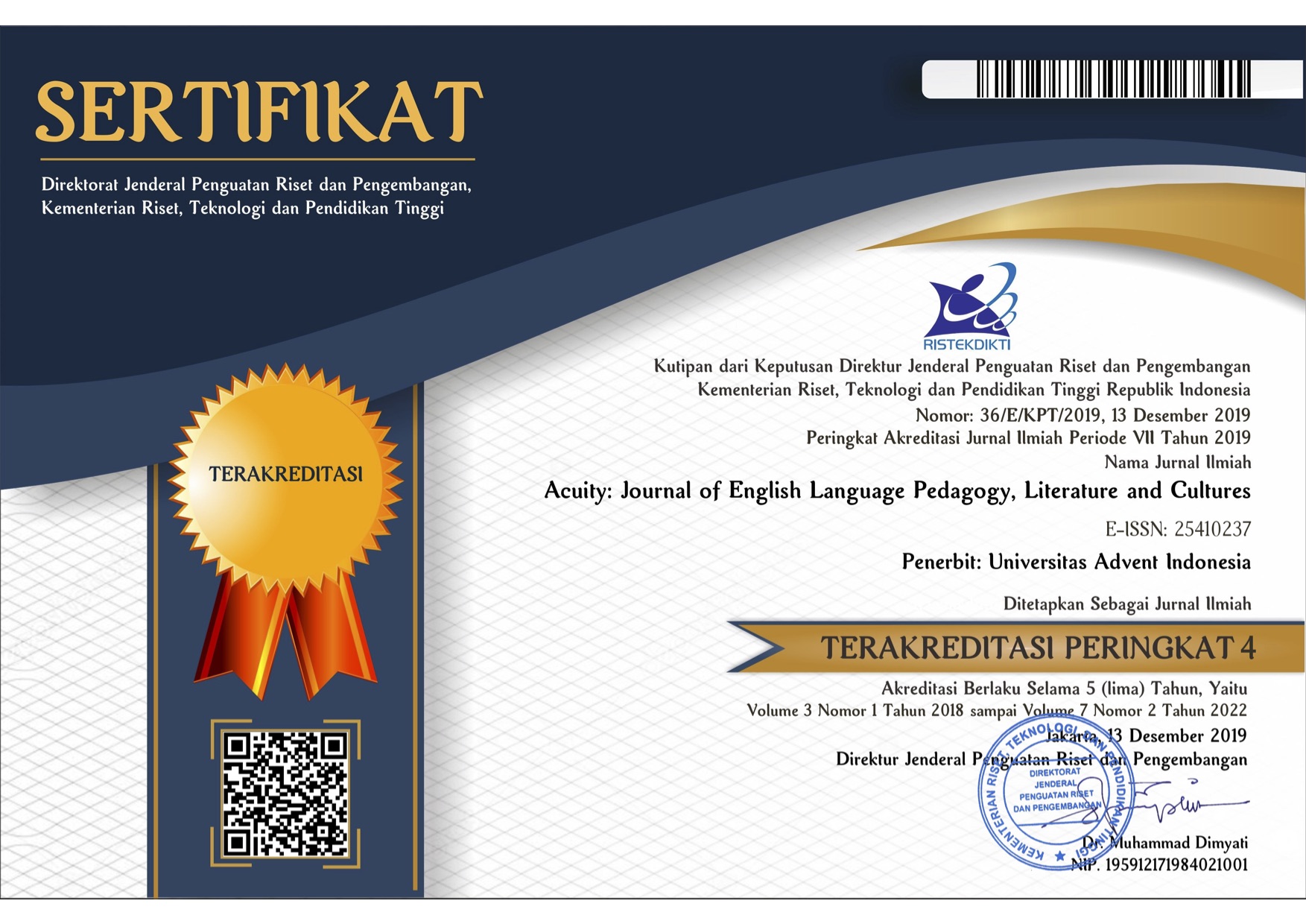Analisis Kesalahan Siswa dalam Menyelesaikan Soal Higher Order Thinking Skill (HOTS) Berdasar Teori Newman
Keywords:
Error Analysis, HOTS, Newman’s TheoryAbstract
The purpose of this study was to find out the errors and factors that cause errors made by students in solving HOTS questions on the subject matter of a three-variable system of linear equations based on Newman's theory. This study is qualitative research with a case study as the research design. The Subjects in this study is a class XI MIPA 2 SMA Negeri 2 Majene in the academic year 2021/2022, totaling 37 students and 2 students from the high and low ability categories and 1 student from the medium ability category using purposive sampling technique. Instrument of this study were HOTS diagnostic test sheets and interview guidelines. The results of this study indicate that the types of errors made by students in solving HOTS questions on the subject matter of the three-variable system of linear equations are: (1) High ability students make comprehension errors, process skills errors, and encoding errors; (2) medium ability student make comprehension errors, transformation error, process skill error, and encoding errors; (3) low ability students make reading errors, comprehension errors, transformation error, process skill error, and encoding errors . In general, the factors that cause errors are not understanding the meaning of the questions, not being used to writing down things that are known and asked, not careful writing the problem information, difficulty changing the problem into mathematical models, unable to design the solution of the problem properly, not being accustomed to writing conclusion answers, and difficulty compiling sentences in the conclusion of the answer.
Downloads
References
Amalia, R., Aufin, M., & Khusniah, R. (2018). Analisis Kesalahan dalam Menyelesaikan Soal Cerita pada Pokok Bahasan Persamaan Linier Berdasarkan Newman Kelas X-Mia di SMA Bayt Al-Hikmah Kota Pasuruan. Prosiding SNMPM II, 346–359.
Arumiseh, N. E., Hartoyo, A., & Bistari, B. (2019). Analisis Kesalahan Siswa Menyelesaikan Soal Cerita Aritmatika Sosial Berdasarkan Newmanâ€TM S Error Analysis Di Smp. Jurnal Pendidikan Dan …, 1–9. https://jurnal.untan.ac.id/index.php/jpdpb/article/view/36086
Brookhart, S. M. (2010). How To Assess Higher Order Thinking Skills in Your Classroom. In Journal of Education. ASCD. https://doi.org/10.1177/002205741808801819
Fatahillah, A., Wati, Y. F., & Susanto. (2017). Analisis Kesalahan Siswa dalam Menyelesaikan Soal Cerita Matematika Berdasarkan Tahapan Newman Beserta Bentuk Scaffolding yang Diberikan. Jurnal Kadikma, 8(1), 40–51. http://jurnal.unej.ac.id/index.php/kadikma/article/view/5229
Fuadi, R., Johar, R., & Munzir, S. (2013). Peningkatan Kemampuan Pemahaman dan Penalaran Metematis melalui Pendekatan Konsektual. Didaktika Matematika, 2013, 47–54.
Kurnia, L., & Yuspriyati, D. N. (2020). Analisis Kesulitan Siswa SMP Dalam Menyelesaikan Soal Aritmatika Sosial Berdasarkan Analisis Newman. Jurnal Matematics Paedagogic, IV(2), 116–119.
Labibah, N., Damayani, A. T., & Sary, R. M. (2021). Analisis Kesalahan Siswa Berdasarkan Teori Newman dalam Menyelesaikan Soal Cerita pada Materi Pecahan Kelas V Madrasah Ibtidaiyah. Journal for Lesson and Learning Studies, 4(2). https://doi.org/10.25273/jipm.v4i2.842
Magfirah, M., Maidiyah, E., & Suryawati, S. (2019). Analisis Kesalahan Siswa Dalam Menyelesaikan Soal Cerita Matematika Berdasarkan Prosedur Newman. Lentera Sriwijaya : Jurnal Ilmiah Pendidikan Matematika, 1(2), 1–12. https://doi.org/10.36706/jls.v1i2.9707
Mahmudah, W. (2018). Analysis of Student Errors in Solving Hots Type Math Problems Based on Newman’s Theory. Jurnal UJMC, 4(1), 49–56.
OECD. (2019). Programme for international student assessment (PISA) results from PISA 2018. Oecd, 1–10. https://www.oecd-ilibrary.org/education/pisa-2018-results-volume-iii_bd69f805-en%0Ahttps://www.oecd-ilibrary.org//sites/bd69f805-en/index.html?itemId=/content/component/bd69f805-en#fig86
Sa’adah, A., Misri, M. A., & Darwan. (2019). Analisis Kesalahan Siswa Dalam Menyelesaikan Soal HOTS Bertipe PISA. Jurnal Mathematic Paedagogic, 4(1), 12.
Singh, P., Rahman, A. A., & Hoon, T. S. (2010). The Newman procedure for analyzing Primary Four pupils errors on written mathematical tasks: A Malaysian perspective. Procedia - Social and Behavioral Sciences, 8(5), 264–271. https://doi.org/10.1016/j.sbspro.2010.12.036
Sugiyono. (2015). Metode Penelitian Pendidikan Pendekatan Kuantitatif, Kualitatif, dan R&D. Alfabeta.
Surya, I. T. M., Suastika, I. K., & Sesanti, N. R. (2019). Analisis Kesalahan Siswa Dalam Menyelesaikan Soal-Soal Materi Operasi Bentuk Aljabar Berdasarkan Tahapan Newman Di Kelas VII SMP NU Bululawang. RAINSTEK : Jurnal Terapan Sains & Teknologi, 1(1), 25–33. https://doi.org/10.21067/jtst.v1i1.3058
T. Hayati, A. Suyitno, I. J. (2016). Analisis Kesalahan Siswa SMP Kelas VII dalam Menyelesaikan Soal Cerita Pemecahan Masalah Berdasar Prosedur Newman. Unnes Journal of Mathematics Education., 5, 8–15.

Downloads
Published
How to Cite
Issue
Section
License
Copyright (c) 2022 Jurnal Padegogik

This work is licensed under a Creative Commons Attribution-NonCommercial-ShareAlike 4.0 International License.
The submitting author warrants that
- The submission is original and that she/he is the author of the submission together with the named co-authors; to the extend the submission incorporates text passages, figures, data, or other material from the work of others, the submitting author has obtained any necessary permission.
- Articles in this journal are published under the Creative Commons Share-Alike Attribution Licence (CC-BY-SA What does this mean?). This is to get more legal certainty about what readers can do with published articles, and thus a wider dissemination and archiving, which in turn makes publishing with this journal more valuable for you, the authors.
- By submitting an article the author grants to this journal the non-exclusive right to publish it. The author retains the copyright and the publishing rights for his article without any restrictions.







